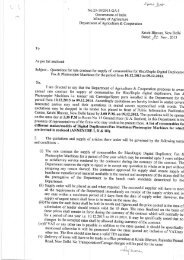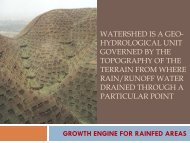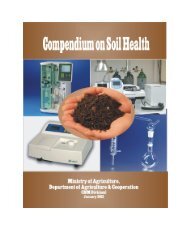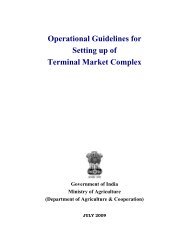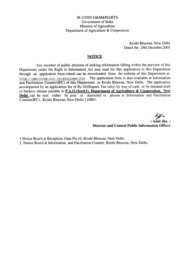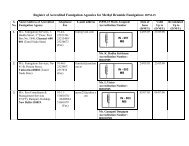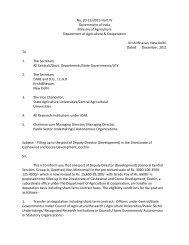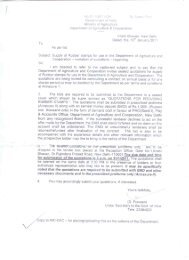canopy management in fruit crops - Department of Agriculture & Co ...
canopy management in fruit crops - Department of Agriculture & Co ...
canopy management in fruit crops - Department of Agriculture & Co ...
Create successful ePaper yourself
Turn your PDF publications into a flip-book with our unique Google optimized e-Paper software.
•<br />
•<br />
•<br />
•<br />
•<br />
•<br />
•<br />
•<br />
•<br />
•<br />
•<br />
•<br />
•<br />
64<br />
Usually, 3-5 well spread laterals are selected as the future scaffold limbs. They<br />
are headed back systematically to short spurs, with two bud each.<br />
This enables new growth at wider angles, which helps <strong>in</strong> formation <strong>of</strong> 3-5 ma<strong>in</strong> limbs,<br />
with reasonably wide angles and strong crotches.<br />
Too many laterals should not be reta<strong>in</strong>ed and crowd<strong>in</strong>g should be avoided.<br />
In second year, 5-7 secondary limbs on ma<strong>in</strong> scaffolds are selected and headed back.<br />
On secondary scaffold, diseased, weak and dry shoots are th<strong>in</strong>ned out and 2 or 3<br />
secondary laterals are selected at this stage.<br />
All the side branches which grow towards the ground, centre <strong>of</strong> the tree or vertically<br />
straight, should be th<strong>in</strong>ned out. The ma<strong>in</strong> stem is kept clear up to 45cm above the<br />
ground.<br />
Peachs require heavy and regular prun<strong>in</strong>g because <strong>fruit</strong><strong>in</strong>g occurs laterally only<br />
on previous season’s growth which bears only once <strong>in</strong> its life time.<br />
The prun<strong>in</strong>g <strong>in</strong> peach has two important components, i.e. th<strong>in</strong>n<strong>in</strong>g out and head<strong>in</strong>g<br />
back <strong>of</strong> shoots. Prun<strong>in</strong>g should be done so as to produce 25-50cm <strong>of</strong> growth annually<br />
under temperate condition, which is sufficient for ma<strong>in</strong>ta<strong>in</strong><strong>in</strong>g optimum productivity.<br />
Dur<strong>in</strong>g early bear<strong>in</strong>g, the selected shoots should be lightly pruned by remov<strong>in</strong>g 20-<br />
30% l<strong>in</strong>ear growth after corrective prun<strong>in</strong>g <strong>of</strong> trees.<br />
After 7-8 years <strong>of</strong> bear<strong>in</strong>g, corrective prun<strong>in</strong>g is followed by removal <strong>of</strong> l<strong>in</strong>ear<br />
extension growth to the extent <strong>of</strong> 70-80%.<br />
The rema<strong>in</strong><strong>in</strong>g 50% <strong>of</strong> selected shoots are headed back by remov<strong>in</strong>g 20-30% l<strong>in</strong>ear<br />
growth.<br />
In general, <strong>fruit</strong> bear<strong>in</strong>g shoots are lightly pruned and alternate ones severely<br />
headed back to get sufficient yield and follow<strong>in</strong>g year’s growth, respectively.<br />
In subsequent years, the prun<strong>in</strong>g severities <strong>in</strong> these two branches are changed<br />
which ma<strong>in</strong>ta<strong>in</strong> the trees <strong>in</strong> grow<strong>in</strong>g and <strong>fruit</strong><strong>in</strong>g condition.<br />
In July Elberta peach, prun<strong>in</strong>g is done to reta<strong>in</strong> 40 <strong>fruit</strong><strong>in</strong>g shoots and each shoot<br />
is headed back to 15 nodes. Where heavy prun<strong>in</strong>g is required, three fourths<br />
head<strong>in</strong>g back plus 40% th<strong>in</strong>n<strong>in</strong>g out is recommended. Mid w<strong>in</strong>ter is best time <strong>of</strong><br />
prun<strong>in</strong>g.<br />
Canopy Management <strong>in</strong> Fruit Crops



